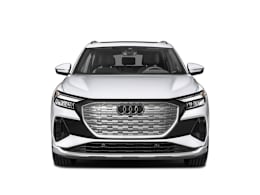Audi’s Q4 E-Tron electric SUV shares its platform with Volkswagen’s ID.4, but it feels like an Audi through and through. It’s quick and quiet, and has a well-finished cabin. Without the indulgent, newfangled controls found in some other EVs the Q4 is easy to drive and live with on a daily basis. We don’t like the feel of its spongy, long-travel brake pedal, though, or the operation of its touch-capacitive steering-wheel buttons, which are tedious to use while driving.
Front and rear motors give the Q4 all-wheel drive, and we saw it scooting from 0 to 60 mph in just under six seconds; while that’s quick compared to most vehicles, it’s slightly slower than rivals such as the Ford Mustang Mach-E, Genesis GV60, and Tesla Model Y. That’s okay with us, because we appreciate that Audi tuned the Q4 to deliver a smoother, less neck-wrenching burst of speed from a stop than some EVs.
With its 82-kilowatt-hour battery pack, the Q4 has an EPA-rated 258-mile driving range, which is competitive. The Q4 Sportback E-Tron is a coupe-like version that compromises cargo space and visibility for the sake of sporty styling.
To its credit, Audi supplies a special heavy-duty plug that’s compatible with an outlet similar to that of an oven or a dryer, potentially eliminating the need to buy a home charger. It takes about nine hours to charge the Q4 from empty on a Level 2, 240-volt setup. The Q4 has a maximum acceptance rate of 175 kW, which can give the car at least 150 miles of range in 30 minutes at a public DC fast-charging station.
Handling is responsive and capable, up to a point: Don’t expect Q5-like agility when you push the pace through turns, due in part because of the extra weight the Q4 carries. With a curb weight of just over 5,500 pounds, it’s about 500 pounds heavier than the larger, three-row Q7 SUV, and you’re well aware of that bulk when you steer it through turns. Still, the Q4 was well-behaved even when pushed to its limits on our track. The ride is steady and composed most of the time, but the suspension feels overly firm when driving on rough pavement at low speeds, such as in a city.
We don’t like that the brake pedal feels like you’re pressing on a sponge when trying to stop. It’s a disconcerting sensation, as the pedal feels like it’s sinking away from you, requiring more pedal pressure at times than seems natural. We appreciate the ability to adjust the regenerative-braking (which slows the vehicle when coasting or braking, while sending energy back to the battery) levels on-the-fly by using the paddles behind the steering wheel, and that the braking force comes on smoothly. But, Audi didn’t give the Q4 true “one-pedal driving,” which would allow drivers to slow to a stop purely by using regen-braking, without having to step on the physical brake pedal.
Cabin quietness is a high point of the Q4. Even by typically-hushed EV standards, it’s super-silent inside the Audi. The front seats are wide, comfortable, and deliver long-lasting support, and both feature four-way lumbar adjustment on the mid-level Premium Plus trim we tested—a nice aid on longer drives. We appreciate the ample space around the driver, with hardly any intrusion from the center console. The rear seat has good head- and knee room, and a well-shaped design that gives passengers a comfortable pocket to sit in.
The Q4’s cabin is more about understated, uncluttered elegance than gimmicky EV-flash. Although it feels mostly well-made, there are too many hard-plastic pieces throughout the cabin for the price Audi is charging. The infotainment system and many of the common controls are well-designed and mostly easy to use. But the touch-sensitive steering wheel controls (rather than physical buttons) require too much precision while driving, and the cruise-control stalk located low on the left side of the steering wheel is cluttered with small, difficult to read text. We also think it’s inexcusable that some of the climate-control toggle switches are unlit at night.
Automatic emergency braking with pedestrian and cyclist detection, blind spot warning, rear cross traffic warning, reverse automatic emergency braking, lane departure warning, lane keeping assistance, and automatic high beams all come standard. For the 2024 model year, lane centering assistance and adaptive cruise control are standard.























